To identify and describe the main caregiver of the patients on the heart transplant waiting list; to compare relevant information provided by patients and caregivers, and to classify the caregivers according to their dedication and efficiency in assisting the patient by correlating them to sociodemographic data.
Descriptive study performed from October 2004 to October 2005 at UNIFESP outpatient clinics. The study sample consisted of 21 patients and their caregivers. Data were collected through a structured interview.
The main caregiver was a family member (95%), usually the spouse. There were 13 women (81%) and three men (19%). Patient age ranged from 24 to 65 years (mean 44.3). Patients were married (56%); catholic (43.8%); 29% have finished elementary school; 24% have finished high school; 14% have higher education; 68.8% have a regular job; and 81.4% had their own income. All caregivers lived in the same house as the patient. Once a score was established, the caregivers were classified as: "good" - 8 (50%); "regular" - 7 (43.7%); and "bad" 1 - (6.3%). The scores were correlated with education, professional activity, and income without any significant statistical correlation.
It is important to determine the instruments to recognize and describe the caregivers. The caregiver is usually a family member (spouse), female, mean age of 44.3 years; has his/her own income and, most of the time, he/she is classified as "good" or "regular", and no correlation was found with education, professional activity and income. Further studies with a larger sample should establish the relationship between the caregiver's role and the heart transplant outcomes.
Identificar e caracterizar o principal cuidador dos pacientes candidatos a transplante do coração; comparar as diferenças entre as informações coletadas com os pacientes e cuidadores; e classificar os cuidadores segundo a sua dedicação e eficiência na assistência ao paciente, correlacionando-os aos dados sociodemográficos.
Estudo descritivo realizado de outubro de 2004 a março de 2005, no ambulatório da UNIFESP, por meio de entrevista estruturada, com amostragem de 21 pacientes e seus cuidadores.
O principal cuidador era membro da família (95%), na maioria das vezes, o cônjuge, sendo 13 (81%) mulheres e três (19%) homens, com idade variando de 24 a 65 anos (média de 44,3). Declararam-se 56% casados; 43,8% católicos; 29% cursaram o ensino fundamental, 24% completaram o ensino médio e 14% tinham nível superior. Atividade profissional era exercida por 68,8% e 81,4% possuíam renda própria. Todos os cuidadores residiam na mesma casa que o paciente. Estabelecido um escore, classificaram-se os cuidadores em oito (50%) "bons", sete (43,7%) "regulares" e apenas um (6,3%) foi considerado "ruim". Não encontramos correlação estatisticamente significante entre o escore e as variáveis escolaridade, atividade profissional e renda.
É importante determinar os instrumentos para o reconhecimento e caracterização do cuidador. Neste estudo, identificou-se um familiar (cônjuge), do sexo feminino, com idade média de 44,3 anos, renda própria, classificados, na maioria, como "bons" ou "regulares", não havendo correlação com escolaridade, atividade profissional e renda. Novos estudos complementares, com casuística maior, deverão estabelecer a relação entre o papel do cuidador e os resultados do transplante cardíaco.
INTRODUCTION
Heart failure is a highly quality of life-threatening disease and when it is compared to other diseases causes, it causes a higher discomfort than agina, chronic obstructive pulmonary disease (COPD), rheumatoid arthritis, and diabetes [1]. Heart failure is a major public health problem with high incidence among the population. It is a major cause of hospital admission leading to high financial costs [2].
One of the alternatives being addressed for heart failure (HF) prevention is to provide information and education to the general population [3]. Some studies have shown that patients with advanced heart failure and their caregivers have just few information about prevention and the contributing causes of cardiovascular problems [4]. Heart transplantation is an alternative of treatment more and more used [5], and the involvement of the caregivers is requested in order to achieve better outcomes.
Caregivers are people responsible for the delivery of health care; those who stimulate the patient during rehabilitation activities and those who establish contact with the patient care team [6]. Most of the time, the caregiver is a family member with or without health care experience, who takes over the patient's health care at home, willingly assisting him to fill his needs providing comfort, leisure and assuring his/her well-being [6]. Currently, heart transplantation represents the conclusive treatment for patients with cardiomyopathy, heart failure refractory to maximum drug therapy and that presenting treatment impossibility through conventional surgery [7].
In the heart transplantation programs social evaluations are worked out in details in order to verify the occurrence of the most adverse factors that further can hamper the inclusion of patients in these programs. The purpose is to identify through interviews the patient's social framework from the stratification of some categories extracted from the activities of daily living structured as follows: acceptance, family dynamics, and socioeconomic access and status [8].
Thus, this study was carried out aiming at to identify the main caregiver of the candidate patients to heart transplantation; characterize the patients according to their sociodemographic data; compare the differences between information collected from the patients and those gathered from the caregivers, and classify the caregivers according to their affection and efficacy in patient care, as well as to correlate them with the sociodemographic data.
METHODS
This is a longitudinal prospective study with quantitative approach carried out from October 1st 2004 to March 31st 2005 at the Federal University of São Paulo Cardiovascular Surgery Hospital Outpatient Clinics - Paulista School of Medicine, after the Institutional Ethics Research Committee approval.
The sample comprised 21 candidate patients to heart transplantation and their respective caregivers. To select the possible caregivers, interviews were performed with the participating patients enrolled in the sample.
Inclusion criteria for enrollment were age > 15 years, to be a candidate for heart transplantation, to be patients' relative or close friend regardless the gender besides agreeing to participate in the study signing a Free Written Informed Consent. Caregivers who were scarce from an illiterate patient over a 3-year period met the exclusion criteria adopted in this study.
Data collection was performed through two instruments. The questionnaire addressed to the patients aims at identifying the caregiver besides seeking information related to the caregiver involvement and identification in the face of expected actions, such as to assist the patients with medications and examinations, escorting him/her to referral and consultation, and hospital admissions.
The questionnaire addressed to the caregivers sought to characterize them in socioeconomic term (schooling and income) besides collecting data to evaluate its "professional quality" classifying it into "good", "regular", and "bad" by means of a score.
The score was established according to 4 questions related to the caregiver involvement with the patient needs. Each question should have only one single answer. A Likert type scale was used, which included the following options: nerve (score 0); hardly ever (1); sometimes (2); most of the times (3); and always (4). In this way, a caregiver could have a score ranging from 0 to 16 as listed in Chart 1.
Data gathered from the questionnaires were tabulated and analyzed using different statistical methods.
Simple frequencies and percentages were used for data related to the patients and caregivers' sociodemographic variables.
Chi- square test or Fisher's Exact test were used to evaluate the caregiver association with some significant characteristics after his/hers categorization. A statistical significance level was established at
a = 5%.
On the Caregiver classification, some patients' score comparisons were also prepared. The nonparametric Mann- Whitney test was used to compare data between the groups. The Kruskal Wallis test was used to compare data among the groups. These nonparametric statistical tests were used because the distribution of the scores does not present the normal distribution pattern.
RESULTS
Data gathered from the patients regarding the caregivers' identification according to activities performed are listed in Figure 1.
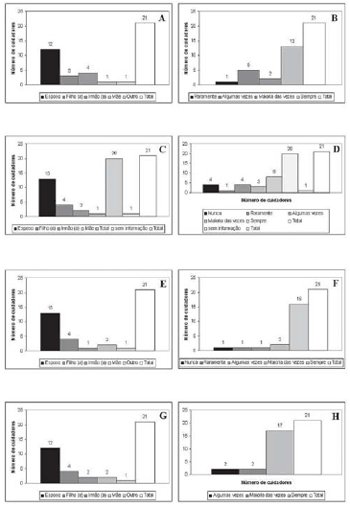
Fig. 1 - A - The spouse is the reference person, responsible for the direct care to the patient. B - The reference people have a great presence by the patient side in the outpatient clinic consultations. C - In most of the cases, one of the spouses is who actually assists the patient, regarding drug prescription, followed by other family members. D - These proportions are identical to the previous data in which the reference people have great presence by the patient side in administering medications. E - Nineteen percent of the patients reported they have never needed assistance to take medications. F- The presence of the patient escort regarding the subsidiary tests. G - One of the spouses is the main escort in a long hospital stay. H - It can be verified that the hospitalizations consist of moments in which the presence of the Escort is more often requested.
Although 21 patients were interviewed, only 16 caregivers could be interviewed. Throughout the research period, only five caregivers did not escort the patients to the outpatient clinic visits. Data gathered are listed in Table 1.
Disagreements were found when a comparison of the patients and caregivers' answers was made. Considering that these disagreements could lead to the identification of different points of view regarding the caregivers' performance, Table 2 shows the valid percentages of these answers in order to allow a more accurate comparison of these data.
It is observed in Table 2 that 6.7% of the caregivers assumed they have never attended the outpatient clinic visits and 12.5% have never helped his/her patient with medications, what was not reported by the patients. On the other hand, at the other extreme it is verified that the percentages of caregivers who reported always to escort the patients to the outpatient clinic visits (66.7%), to help with the medications (56.3%) and admissions (100%) are higher than those reported by the patients for the same activities (61.9%, 50%, and 81%, respectively).
The analysis of the distribution of the scores ascribed to each one of the caregivers according to their answers is presented in Table 3.
The correlation between the caregivers' level of schooling, professional practice, and income with the score attained on their categorization is shown in Tables 4 to 6. These correlations were performed aiming at evaluate whether these factors could influence the caregiver's performance quality along with the patient.
DISCUSSION
The heart transplant candidate requires a strict control of the cardiac function both for his/hers registration on a waiting transplantation list as to assure the maintenance of his/hers clinical conditions during the waiting period for a new heart. This is a period characterized by anxiety and anguish during which the patient becomes weakened and usually seeks for the support of one or more people in whose he/she can depend upon. These are the people who assume the role of being the link between the patient and the health team. This is the person referred to as the "caregiver".
The caregiver usually is divided into two groups: the informal caregiver is the one who belongs to the group composed by the family, friends, and volunteers; the formal caregiver is the one who has practical and theoretical background to assist the patient at home, such as physicians, nurses, and physical therapists [9].
However, according to the observation of some authors [6], the caregiver is a family member with or without health care experience who assumes the patient's health care at home willingly to supply his/hers needs, in most of the cases. Therein, it is important to consider the family as a critical part in the human care on account of its role of sharing with the patient its fears, distresses and joys even promoting a greater mutual understanding among them [10].
The study outcomes demonstrate that on the identification of the caregivers by the patients, according to the activities performed, a family member was designated as the main caregiver and most of the times the spouse was pointed out, regardless the activities studied. Nevertheless, these data corroborated the literature findings regarding the caregivers' role in health care, highlighting the importance of the family in the context of high-complexity managements [6,11-14].
The waiting on the heart transplant waiting list can be long, therefore, it is a great challenge to keep a recipient alive and in good clinical and emotional conditions. It was observed that the caregiver attending the consultations along with the patient takes part of the aspects related to the delivering of the patient data, providing significant information as to the medications, examination dates, food habits, besides signs and symptoms presented by the patients. These are significant aspects of the caring.
In hemodynamically unstable patients, hospitalization is sometimes necessary in order to optimize their clinical conditions. This optimization is undertaken by administrating inotropic drugs, using intraaortic balloon, or other circulatory support devices by varying time periods, thus, minimizing the perioperative risk, while still in the waiting transplant list [15,16].
All these activities performed by the candidate patient for a transplant cause his/hers caregiver to have also a very high range of responsibilities because it is his/her duty to follow-up the patient throughout all the stages. It is worth mentioning that the presence of a companion is always requested by the health care team in an attempt to make the patient an essential part of the whole process.
For the purposes of the current study, the following activities were considered as critical: 1) patient's follow-up to the outpatient clinics; 2) patient's follow-up to the specific examinations; 3) support to the administration and control of drug therapy; and 4) the follow-up during hospitalizations.
The caregiver's follow-up answer was always reported by the patients in the following activities: drug intake, 61.9%; performance of test, 61.9%; escorting patients throughout hospitalization, 57.1%, and escorting the patient to outpatient clinic visits. On the other hand, four patients (19%) reported they have never been followed-up in drug intake and one patient (4.8%) was never followed-up in the tests, which is worrying evidence. Although the sample size poses limitations for a wide generalization, these percentages allow implying that the fact of not being escorted is a fact present in the life of a number of patients, what could reflect in patients' evolution regarding pre- and post-transplantation procedures.
The study by Walden et al. [4] describes the importance of the continuing education of both candidate patients for heart transplantation and their caregivers, highlighting the importance of these later in the process. However, it is important to keep in mind that the population socioeconomic conditions itself concerning the study, discussed next, maybe come to justify this absence owing to the caregivers pure and simple difficult to leave their jobs to stay close by the patients at all moments.
The family can be touched enough by the disease and treatment that causes an unbalance leading to difficulty development in providing support to the patient even causing harm to the patient's recovery [11]. However, it would be necessary to deepen this matter by means of new studies focusing specifically the causes of these absences. In the same way, although along data collection the importance of the caregiver attending the consultations have been emphasized by patients and health professionals (by providing both higher reassurance and assistance to fix information) the study data do not allow estimating its impact regarding the compliance behavior to patients' treatment. Thus, the study outcomes also highlight the need to perform specific research along with this population seeking to prove this impact.
In the presence of the caregivers' sociodemographic characterization, the study included 16 female caregivers (81%), which is supported the data pointed out by other authors as well [12,17] who presented a higher prevalence of female caregivers for those patients who required heart transplantation. Studies related to the caregivers of other patients' groups also presented similar outcomes [18-22] and some emphasized the caring impact on health and women's quality of life [23].
The research showed that the caregivers' mean age was 44.38 years which was similar to other authors [12] and different from some authors [19] who found caregivers relatively younger, or who presented the utmost extreme age of 73 years [20], a relatively common fact among caregivers of elderly patients in which one of the spouses, also an aged person becomes the caregiver of the other.
Regarding marital status, 56% of the caregivers interviewed were married and most of them (56%) was the patient's own spouse, as previously discussed. Although this is in itself a positive fact for the patient in many instances, because allows associating to the care the affectional component linked to a well-settled marital relationship adding to it affection and devotion, the marriage brings to the caregiver an additional burden, especially when there are children involved.
Concerning to religion, all caregivers stated they were Catholic and Evangelical (43.8% vs 25%, respectively). These findings are the expected ones, keeping in mind that Brazil although presenting a great diversity of cultural influences and religious ones as well still is predominantly dominated by tradition religions, such as the Jewish- Christian, in which the role of the care is often attributed to the woman and also to the charity.
On studying the level of schooling variable, the study showed that the caregivers attended Elementary School, or reported to have finished Secondary School, and fewer where those who have finished undergraduate or graduate studies. The outcomes related to the level of schooling were similar to that of other authors [19,22] in which there is a prevalence of those who attended Elementary School.
Caregiver's professional practice and income are constituent factors that should be analyzed as a whole. Most of the study caregivers reported to perform some kind of professional indoor or outdoor practice and to have personal income (in two cases from the retirement pension and not from the professional practice) in order to help or even to reinforce household budget.
When comparing escorts and patients' answers, interviews with both patient and his/her caregiver allowed identifying some contradictory answers as to the caregivers' behavior.
In general, it is observed that the patients reported to be escorted by the caregivers to the outpatient clinic visits. The same can be observed in the answers relating to the item "help with medications", in which the percentages presented slightly different between both responders' groups. Although percentually small, such standpoint differences could reflect communication problems between caregiver and patient, or even the difficulties of understanding the meaning of the question asked. Patients and caregivers' reports, however, actually allowed deducing that the answers reflect the fear that this could impair the patients' inclusion on the transplant waiting list.
The caregivers' classification score is obviously considered an extremely superficial and subjective evaluation because it represents only the numerical data collected without taking into consideration motivations and difficulties faced by the caregivers.
The description score was applied concerning their caregiving among the 16 caregivers evaluated, as follows: eight (50%) caregivers were given the score "good", seven (43.7%) were appraised as "regular", and only one (6.3%) was considered "bad". It is worth mentioning that five caregivers, although reported by the patients, were not present during data collection and could not be found by the lead researcher. Despite not being considered by statistical analysis in score attribution, one can consider that not being present to any consultation during the study data collection is an evidence to classify these caregivers as "bad". This datum, added to the fact that only half of the sample analyzed was classified as "good" caregivers, serves to identify some aspects that could contribute to a debate concerning the need to review the social support issue for patients in the heart transplant waiting list.
The scores were also correlated to some of the sociodemographic data (schooling, professional practice, and income) seeking to verify if these variables could influence in the caregiver "quality".
It was observed that none of these variables statistically presented any significant correlation with the profile of the scores. However, it must be highlighted that given the sample size, the sensitivity of the Fisher's exact test may have decreased.
Concerning the level of schooling and income, the distribution of the scores in the different levels is homogeneous enough, actually suggesting that these factors are indeed irrelevant. It is interesting to observe, however, that regarding professional practice, although the number of "good" caregivers is the same between those who answer "yes" and "no", there is a concentration of "regular" and "bad" caregivers among those engaging in some professional practice. This is a situation that could be related to the caregivers' age of the study sample and also to the fact that the caregiver is one of the spouses, in most of the cases.
Considering that the candidate patients for a heart transplant usually are young individuals, in a productive age, and that the disease itself causes to be necessary their leave, it is reasonable to assume that the spouse took the family burden upon himself/herself.
In this context, the role of breadwinner overlaps the caregiver and not always enables this individual to play the role which is expected from him/hers. Taking into consideration the importance attributed to this role not only by the health care team but also by the patient himself/ herself, and also widely supported by the existing literature [6,11,12,22,23], we could verify the need of further investigating this situation by means of a sociological study in order to propose alternatives to provide social support for this group of patients.
Considering this, it is necessary to implement strategies aiming at providing a support to the caregiver, besides the patient, so that the out-of-hospital management to the candidate to a heart transplant is the most satisfactory as possible. Heart transplant is a high-cost procedure to the Unified Health System (SUS), thus, it is requested that the conditions in which heart transplantation is performed, be the best as possible to assure its success.
CONCLUSIONS
We should take into consideration that the human beings are not an "island", do not develop in isolation, need to live in community and, through its evolution, friendship actions and aid to the poor in many different aspects was always of a vital concernment; this is noble and which makes human beings different from other animals. The caregiver serves a critical role in the follow-up of a candidate to a heart transplant. The present study demonstrated that the caregiver is a family member (spouse), female, mean age of 44.3 years, with a personal income and in the most of the instances, classified as "good" or "regular" caregivers. There is no correlation among schooling, professional practice, and income. However, further studies with a higher rationale are needed in order to establish the relationship between "caregiver" and "outcomes" regarding heart transplant. The purpose of this study is to encourage new researches in this so little explored field.
REFERENCES
1. Branco JNR, Aguiar LF, Paez RP, Buffolo E. Opções cirúrgicas no tratamento da insuficiência cardíaca. Rev Soc Cardiol Estado de São Paulo. 2004;14(1):11-5.
2. Rossi Neto JM. A dimensão do problema da insuficiência cardíaca do Brasil e do mundo. Rev Soc Cardiol Estado de São Paulo. 2004;14(1):1-6.
3. Sousa RL, Santos FJC, França KM, Costa SKT, Medeiros Neto AH, Quinino SCM. Revisão das II diretrizes da Sociedade Brasileira de Cardiologia para o diagnóstico e tratamento da insuficiência cardíaca. Arq Bras Cardiol. 2002;79(Suppl 4):3.
4. Walden JA, Dracup K, Westlake C, Erickson V, Hamilton MA, Fonarow GC. Educational needs of patients with advanced heart failure and their caregivers. J Heart Lung Transplant. 2001;20(7):766-9. [
MedLine]
5. Boaz MR, Bordignon S, Nesralla IA. A importância de medidas preventivas na profilaxia de infecções em pacientes submetidos a transplante cardíaco nos primeiros 30 dias de pós-operatório. Rev Bras Cir Cardiovasc, 2006;21(2):188-93.
6. Jukemura MFM. O cuidador familiar de pacientes submetidos à cirurgia gastro-intestinal de grande porte: suas atividades no domicílio [Dissertação de Mestrado]. São Paulo:Escola de Enfermagem da Universidade de São Paulo;2002.
7. Diniz RVZ. Tratamento da insuficiência cardíaca congestiva. In: Unifesp/Escola Paulista de Medicina. Guias de medicina ambulatorial e hospitalar. São Paulo:Manole;2004. p.334.
8. Branco JN, Costa ISEA, Lobo Filho G, Moraes CR. I Diretrizes da Sociedade Brasileira de Cardiologia para transplante cardíaco: IX. Organizaçäo do transplante cardíaco no Brasil. Arq Bras Cardiol. 1999;73(Suppl 5):56-7. [
MedLine]
9. Karsch UMS. A questão dos cuidadores. In: Congresso Paulista de Geriatria e Gerontologia. São Paulo;1998. Anais.p.28-31.
10. Althoff CR. Pesquisando a família: a experiência da Enfermagem na UFSC. Rev Família Saúde Desenvolvimento. 1999;1(1/2): 49-56.
11. Silva RM, Melo EM, Rodrigues MSP. Família como suporte para a mulher em tratamento quimioterápico. Rev Família Saúde Desenvolvimento. 1999;1(1/2): 87-96.
12. Guerra CICO. Fatores de risco para o desgaste do cuidador familiar de paciente na fila do transplante cardíaco [Dissertação de Mestrado]. São Paulo: Escola de Enfermagem da Universidade de São Paulo;2002.
13. Bocchi SCM. Vivenciando a sobrecarga ao vir-a-ser um cuidador familiar de pessoa com acidente vascular cerebral (AVC): análise do conhecimento. Rev Latino-Am. Enfermagem. 2004;12(1):115-21.
14. Bocchi SCM, Angelo M. Interação cuidador familiar-pessoa com AVC: autonomia compartilhada. Ciênc. Saúde Coletiva. 2005;10(3):729-38.
15. Loh E. Overview: old and new controversies in the treatment of advanced congestive heart failure. J Card Fail. 2001;7(2 suppl 1):1-7. [
MedLine]
16. Moreira LFP, Galantier J, Benício A, Leirner AA, Fiorelli AI, Stolf NAG, et al. Perspectivas da evolução clínica de pacientes com cardiomiopatia chagásica listados em prioridade para o transplante cardíaco. Rev Bras Cir Cardiovasc. 2005;20(3):261-9.
17. Young E, Little M. Women and heart transplantation: an issue of gender equity? Health Care Women Int. 2004;25(5):436-53. [
MedLine]
18. Scazufca M. Brazilian version of the burden interview scale for the assessment of burden of care in carers of people with mental illnesses. Rev Bras Psiquiatr. 2002;24(1):12-7.
19. Nakatani AYK, Souto CCS, Paulette LM, Melo TS, Souza MM. Perfil dos cuidadores informais de idosos com déficit de autocuidado atendidos pelo Programa de Saúde da Família. Rev Eletrôn Enferm. 2003;5(1). Disponível em: http://www.fen.ufg.br/revista
20. Cattani RB, Girardon-Perlini NMO. Cuidar do idoso doente no domicílio na voz de cuidadores familiares. Rev Eletrôn Enferm. 2004;6(2). Disponível em: http://www.fen.ufg.br/revista
21. Hora EC, Souza RMC. Os efeitos das alterações comportamentais das vítimas de trauma crânio-encefálico para o cuidador familiar. Revista Latino - Americana de Enfermagem 2005;13(1): 93-8. [
MedLine]
22. Lledós MPS, Blanco AA, Gascón AC. Morbilidad sentida y diagnosticada em cuidadores de pacientes inmovilizados de uma zona de salud rural. Rev Esp Salud Publica. 2002;76(6): 713-21. [
MedLine]
23. García-Calvente MM, Mateo-Rodriguez I, Maroto-Navarro G. El impacto de cuidar em la salud y la calidad de vida de las mujeres. Gac Sanit Barcelona. 2004;18 (suppl.2): 83-92.


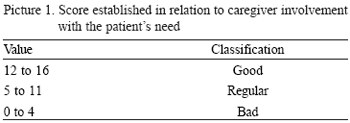
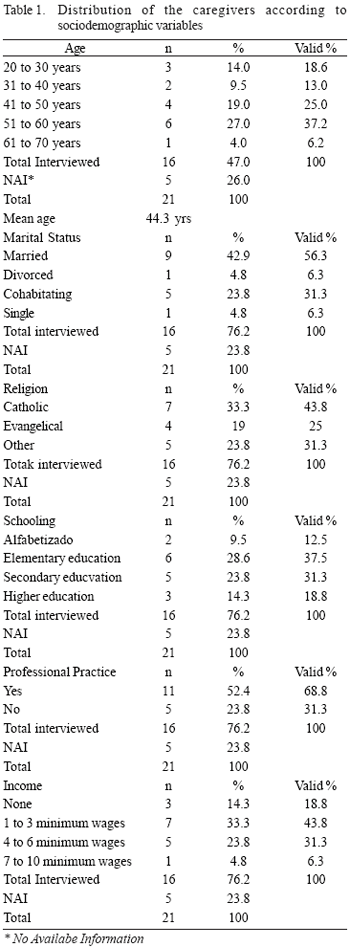
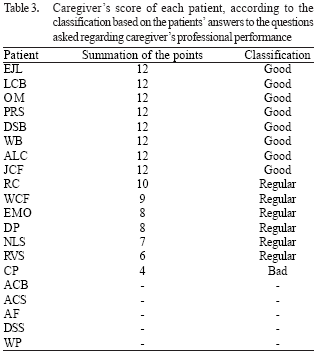
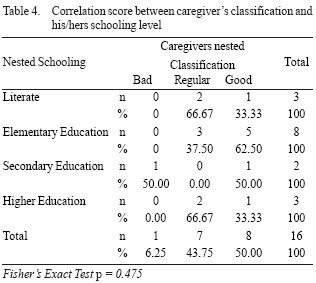
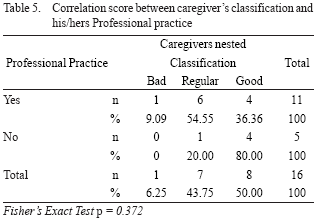

 All scientific articles published at rbccv.org.br are licensed under a Creative Commons license
All scientific articles published at rbccv.org.br are licensed under a Creative Commons license